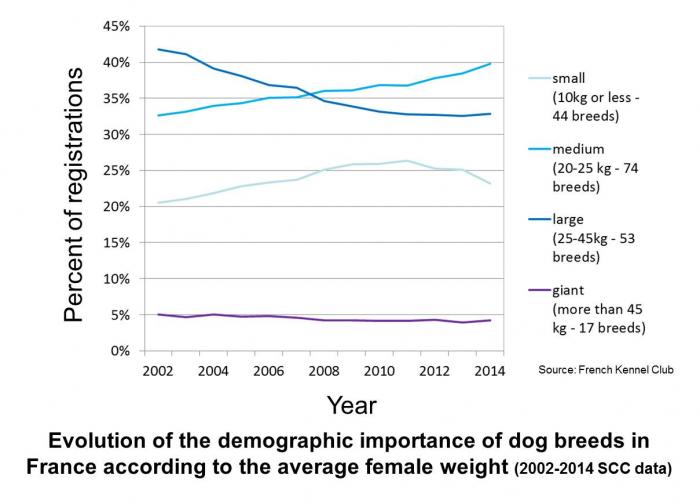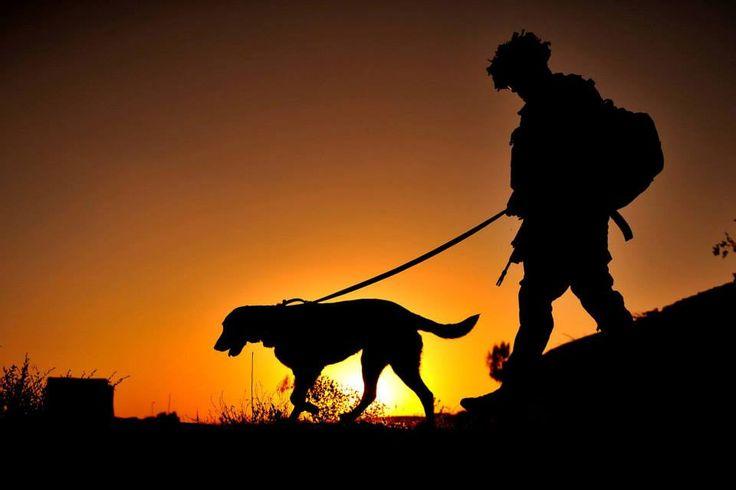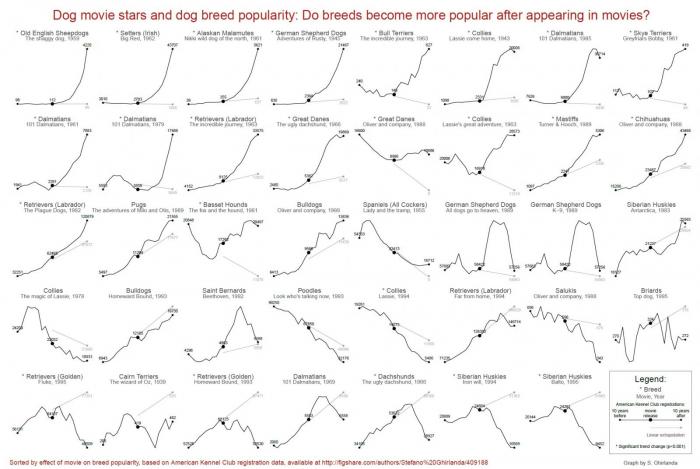Dog size, breed popularity and fashion effects
 In a last post, we saw how different breeding parameters are impacted by the size and the weight of the dogs. It has yet to be stated that these parameters may also, more or less directly, impact breed demographics, in relation to fashion trends which will make some dog breeds popular or not.
In a last post, we saw how different breeding parameters are impacted by the size and the weight of the dogs. It has yet to be stated that these parameters may also, more or less directly, impact breed demographics, in relation to fashion trends which will make some dog breeds popular or not.
The figure below illustrates the evolution of population size in France according to the average female weight of the breeds. Large breeds (and in a lesser extent giant ones) have experienced a clear decline in popularity over the last twelve years, as they accounted for 42% of total French registration in 2002, while this proportion has dropped to 33% in 2014 (note the situation appears stabilized over the last four years). By contrast, medium breeds registrations have increased steadily over the period, ranging from 33% in 2002, to 40% in 2014. It is also interesting to remark that the proportion of registrations from small breeds has reached a peak in 2011 (26%), and has gradually declined since.
 Of course, such results are only national ones and should not be extrapolated outside France, as local trends may differ across countries. Also, if dog size can by itself be an explanatory factor, as owner may change their taste and consider large dogs are less convenient (in relation to feed expense for instance), other parameters may also influence dog popularity over time. For instance, legislation on ear cropping has impacted dramatically the popularity of some breeds: in France, registrations of Doberman and Beauceron plunged between 2002 and 2009 from 2,338 to 786, and from 3981 to 2656, respectively. Note also that some breeds may constitute perfect counter-examples of global tendencies: the Cane Corso, a breed of large size with ear traditionally cropped, experienced an impressive increase of its registrations from 1,232 to 4,687 dogs over the 2002-2014 period. Another well-known factor is of course the popularization of dog breeds through movie (and other media) featuring them. A few months ago, a study investigated the extent of the phenomenon in USA, confirming the influence of movie on breed popularity (Ghirlanda et al. 2014).
Of course, such results are only national ones and should not be extrapolated outside France, as local trends may differ across countries. Also, if dog size can by itself be an explanatory factor, as owner may change their taste and consider large dogs are less convenient (in relation to feed expense for instance), other parameters may also influence dog popularity over time. For instance, legislation on ear cropping has impacted dramatically the popularity of some breeds: in France, registrations of Doberman and Beauceron plunged between 2002 and 2009 from 2,338 to 786, and from 3981 to 2656, respectively. Note also that some breeds may constitute perfect counter-examples of global tendencies: the Cane Corso, a breed of large size with ear traditionally cropped, experienced an impressive increase of its registrations from 1,232 to 4,687 dogs over the 2002-2014 period. Another well-known factor is of course the popularization of dog breeds through movie (and other media) featuring them. A few months ago, a study investigated the extent of the phenomenon in USA, confirming the influence of movie on breed popularity (Ghirlanda et al. 2014).
As showed in the figure above, it appears that the influence of movies on dog popularity although clear, has surprisingly declined over the last 70 years. Indeed, in comparison to past movies, (the 101 Dalmatians, Lassie …) recent ones have only minor influence on the registrations of the breeds featured. Also, they can be exceptions to this tendency, as illustrated by one of the authors in his blog (see below). A previous study of the same authors (Ghirlanda et al. 2013) was not able to relate popularity and fluctuations in popularity with breed behavioral features, leading them to conclude that breed popularity is more determined by fashion than function. Actually as illustrated by these different results, breed demographics appear impacted by a wide diversity of factors.
In relation to this issue, one interesting question remains how popularity impacts the health and welfare of dog breeds. It is generally believed that huge popularity is a bad thing for breed welfare, as some producers will focus more on increasing the number of puppies produced, and less on health improvement. One of the aforementioned studies (Ghirlanda et al. 2013) investigated also the relation between popularity of a given breed in USA and UK and its health, considering the number of disorders reported within the breed. In both countries, a positive correlation was found between both parameters. Yet, such result does not necessarily prove that there is a causal relationship between popularity and breed health. Indeed, within a given breed, the number of dogs that are monitored medically is proportional to the size of the population; it is therefore not surprising to identify a larger number of disorders in large populations. Interestingly, authors also found that breeds with more disorders reported tend to decrease in popularity over a ten year period, which has been interpreted as the fact that owners may have started to avoid breeds considered as unhealthy.
Actually, there is, to my knowledge, a lack of data to prove an eventual deleterious impact of popularity on dog health. When considering evolution of genetic variability, it is of course expected that when comparing two breeds of similar size, the first having experienced a recent increase in popularity, it will probably have a narrow genetic base in comparison to the second one. Yet, in any case, for the first breed, situation will be better than if it population size had not increased at all, as in future, the number of reproducers used within the breed is expected to be higher. Therefore, from a genetic variability point of view, increased popularity is a good thing. The risk is probably more related to the fact that breeders could make inadequate choices of reproducers. Eventually, we may hypothesize that increased popularity of a given breed may decide new breeders (either inexperienced or more interested by profit than dog welfare) to breed. Case-studies may provide eventual insight on the eventuality of such risk, providing an idea of cost-benefits behind a sudden increase of population size.
References
- Ghirlanda S., Acerbi A., Herzog H.A., Serpell J.A. (2013) Fashion vs. function in cultural evolution: The case of dog breed popularity. PLoS ONE 8: e74770.
- Ghirlanda S., Acerbi A., S., Herzog, H.A. (2014) Dog movie stars and dog breed popularity: a case study in media influence on choice. PLoS ONE 9(9): e106565
Thanks to Alberto Acerbi for information provided from his blog.
Credit picture: I. Horvath
 Donate
Donate



0 Comments
Recommended Comments
There are no comments to display.